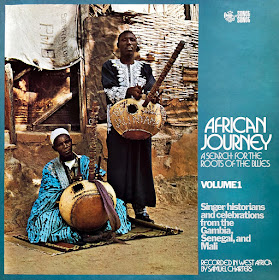ERITREA – ÉRYTHRÉE
Music of Eritrea – Ethiopia Vol. 3 – Tangent Records TGM 103, recorded by Jean Jenkins, released 1970 (LP)
Music of Eritrea – Ethiopia Vol. 3 – Tangent Records TGM 103, recorded by Jean Jenkins, released 1970 (LP)
This excellent anthology showcases Eritrea’s mosaic of languages, cultures, religions, and ways of life, from Muslim desert nomads to Christian Orthodox highland farmers, and the Kunama people who follow their own spiritual traditions.
Eritrea gained its independence from Ethiopia and became a sovereign state in 1993.
Cette excellente anthologie présente la riche mosaïque de langues, de cultures, de religions et de modes de vie de l'Érythrée, allant des nomades musulmans du désert aux cultivateurs chrétiens orthodoxes des hauts plateaux, en passant par le peuple Kunama qui suit ses propres traditions spirituelles.
L'Érythrée accède à l’indépendance et devient un État souverain en 1993.
A1 & A2 – The Arabic-speaking Rashaida people are nomads inhabiting the desert coastal lands of northeastern Eritrea. These two captivating tracks feature female voices and drums recorded during an all-night celebration (also see photograph below).
A3 – The pastoral Beni Amer people live between Agordat and the Sudanese border. A man sings the story of a cow with a five-string rebaba bowl-lyre and ululating women.
A4 – The Baria people live in the arid Gash River region in Western Eritrea. Girls drum, clap, sing, and dance to the beat while men leap in the air with their spears (see front cover).
A5 – The pastoral Afar people from the vast southern expanses between the Buri peninsula and Djibouti along the Red Sea coast lead a nomadic life in search of pasture for their herds. Here a group of Afar, near Mersa Fatima, sing and clap after a wedding celebration.
A6 – The Serae people belong to the Eritrean Christian Orthodox tradition. This stunning circular polyrhythmic music includes a long embilta horn, notched flutes, malakat trumpets, a chirawatta single-string fiddle, and large koboro church drums. Recorded at a feast in Adi Ugri.
A7& A8 – The church service of the Eritrean Christian Orthodox Church consists of two main parts: the qeddase liturgy (A7), directed by the Abuna (Bishop) Mikael Gebre Egziablher and recorded in the chapel of the Imperial Palace in Asmara; and the long Sunday service in which the congregation participates (A8). The only instruments used for the service are tsenatsil sistrums – associated with ancient Egypt – wielded by all members of the congregation, whose gently tinkling sound may be heard on this band, and the large Koboro drums played by the priests, who also dance.
The Eritrean Christian Orthodox Church has been the most isolated Christian church, which may account for the purity and richness of what is perhaps the oldest Christian church music in the world.
B1 – The Assaorta people are semi-pastoralists who cultivate the foothills of Akeleguzal during the summer and come down on the Red Sea coast with their cattle, camels and goats during the winter. They have an elected chief and are devout Muslims. The chief of the Minifere group near Arafuli is leading the Friday prayer. He uses Arabic for the scriptures from the Koran and most of the prayers are in Saho.
B2 – The Kunama people from the Barentu district, who practice their own spiritual traditions are known for their music. The funfera flute, recorded at Dukambia, has a deeper tone than most other flutes played by wandering cow herdsmen.
B3 – Zar evil spirits are said to invade the human body or mind and cause illness or pain and must therefore be exorcised. The leader of the zar ceremony inherited his special curative powers and spells from his father and grandfather, along with mastery of the five-string rebaba lyre, empowered with beads, amulets and mirrors, which can help call the zar from the afflicted person. The nightlong drumming, singing and praying often put the participants and the afflicted person in a trance-like state, when the zar is most easily exorcised.
B4 – The Bilen people farm the uplands near Keren. Girls are drumming and singing at a wedding.
B5 – The historical ballad of Negus is widespread in Eritrea, especially in Hamasien, Akeleguzai and Serae. The soloist sings in the Tigrinya language, accompanying himself on a steel-string kerar bowl lyre.
B6 – Kunama girls beat large drums to dancing men at a feast near Barentu which lasted two full days. And the vigorous dancing and singing continued unabated.
B7 – If one sings to a cow she will give her milk more easily. The Tigre-speaking chief of Afta, a village in the Zula district on the Red Sea, sings with great intensity to encourage his cow and then praises her for feeding everyone at home when the milk starts to flow.
*Condensed and paraphrased from the liner notes of Jean Jenkins.
Download
***
Jean Jenkins (1922-1990) was a major 20th century ethnomusicologist known for her seminal recordings of traditional music, notably from Africa, central Asia, and with a specific focus on the music in the world of Islam. She also wrote books and diaries, took many excellent photographs, and built a traditional musical instrument collection which she donated to the National Museum of Scotland in 1980.
Rashaida People (tracks A1-A2) – Eritrea
Please help me purchase important traditional records to pursue my global
curation project and share the best finds with you on this blog:




























